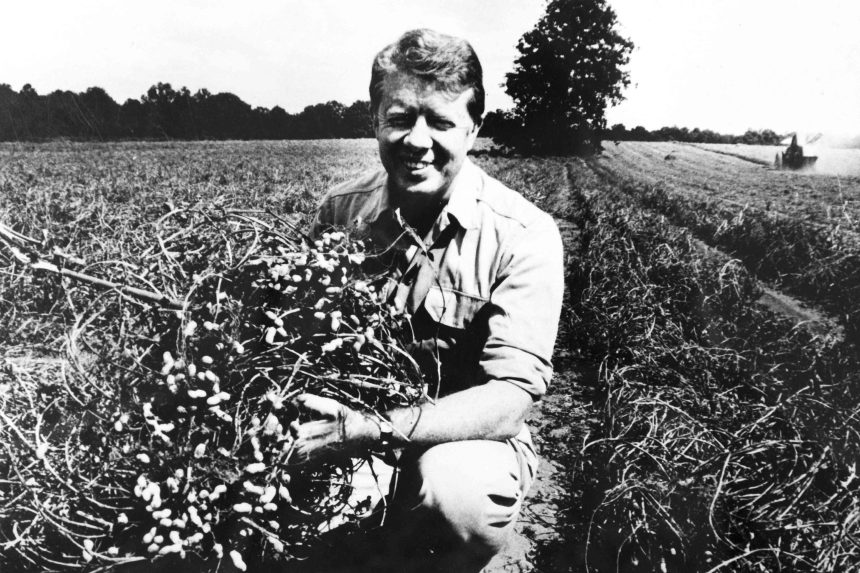From the F&W Archives
In July, 1978, a year and a half into Jimmy Carter’s term as the 39th president of the United States, legendary food and nutrition reporter Marian Burros explored the dining habits and policy stances of the Carter family in a Food & Wine story called “The White House vs. Additives.” Mr. Carter died on December 29, 2024 at the age of 100, leaving behind a legacy of charity, often focused on healthy food access for all Americans, regardless of income.
America’s First Lady says her “gut reaction” to any food product suspected of being a health hazard is, “Remove it, find out if it’s safe, and then put it back on the market if it is.” Her reaction runs counter to the way the government works.
Rosalynn Carter believes that, “If something is known to be dangerous, we ought to know about it and not wait until after it’s tested. I don’t think we ought to suffer until we find out.” She also has little patience with “committees to study problems and a study to study the study.
Having grown up on a farm where very little was done to food before it reached the stove, she worries about food additives. When she was still doing the family cooking and shopping, she says, she used “to try to read ingredients” on the package and would “get distressed in the grocery store” when she found that “everything isn’t labeled. You have to know what you’re eating!” In addition, she thinks it would be good to have some kind of control over nutritional claims that can be made in television commercials.
“The Carters are very diet and nutrition conscious.” Mary Hoyt says. During the campaign, Mrs. Carter said, the first thing they did when they got back to Plains was “to go to the store and buy fresh vegetables because we got so few vegetables when we were traveling.”
The President is probably more knowledgeable than most men about food. In fact, he taught Rosalynn how to cook. According to Mrs. Carter, *When we were first married, Jimmy cooked as much as I did.” Neither cooks now, however — they have four chefs. But living in the White House has not changed their preference for simple foods, especially lightly cooked vegetables.
Even though they could have perfectly executed hollandaise over their asparagus or béarnaise for their filet, executive chef Henry Haller makes sauces only when there are official functions.
Fun fact:
“It’s Carter administration policy to serve American wines only, and for state dinners, they’re usually California selections.” — Food & Wine, Summer 1980
The lunches the Carters eat together in the White House are just like those they ate when the president was a peanut farmer and his wife kept the books at the peanut warehouse: homemade soup and a sandwich on whole-wheat bread. Amy takes the same thing to school in her lunch pail. Desserts are almost as rare as sauces. The pastry chef makes them only for Sunday dinner or when there are guests. The Carters trace their preference for unadulterated foods to their upbringing on farms: “Everyone in Georgia had their own gardens, their own cows and hogs, Mrs. Carter explains.
While the President and First Lady continue to eat as they always have, 10-year-old Amy’s diet has undergone some drastic revisions. During the campaign her grandmother. Miss Lillian took care of her. And like most grandmothers, Miss Lillian indulged Amy.
“It’s unbelievable what I find in the refrigerator when I go home,” Mrs. Carter said at the time. “Doughnuts, honeybuns, candy. Those kinds of things, because that’s what Amy likes to eat.”
Amy’s diet became a domestic sore spot with Rosalynn: “With her grandmother, Amy eats more sweets than I would like her to have. She’s gotten pretty bad now.” During the brief periods when she was home, Mrs. Carter attempted to undo what Miss Lillian had wrought: “I tried to teach Amy that there are things you can eat between meals that are good for you, like fruit and natural cereal, and there are things you ought not to eat.”
Now that she is again overseeing the family refrigerator, Amy snacks on apples, bananas, and sometimes a homemade cookie. Doughnuts and candy are for very special occasions.
Jimmy Carter may have the distinction of being the first President to call attention to the relationship between diet and disease and to set the American Medical Association’s teeth on edge at the same time. When he proclaimed February as Heart Month, Carter told representatives of the American Heart Association that the “decrease in deaths resulting from heart disease and stroke … is primarily because of the good work you are doing in educating people on what we need to do in simple things: regular medical checkups, a good diet, watch your salt intake and get exercise.”
Marian Burros
Jimmy Carter may have the distinction of being the first President to call attention to the relationship between diet and disease and to set the American Medical Association’s teeth on edge at the same time.
— Marian Burros
For years the Carter family’s eating habits have been similar to those outlined in an extremely controversial report published by the Senate Nutrition Committee, chaired by Senator George McGovern, called “Dietary Goals for the United States.” It recommends that Americans drastically decrease their consumption of fats, sugar, and salt and increase their consumption of vegetables, fruits, and whole-grain products. It also says that consumption of food additives should be reduced “to the greatest degree possible” because there are so many which may not be safe.
But the AMA has taken strong exception to “Dietary Goals.” In a 12-page diatribe, the AMA says evidence that Americans would be better off if they changed their eating habits is “insufficient,” “conflicting,” “fragmentary,” and might even be harmful. As far as the AMA is concerned, an ounce of cure is worth a pound of prevention.
Clearly, the Carters’ concerns about the safety of food, about the relationship between what we eat and how well we live, may anger a lot of special-interest groups. But that isn’t going to influence the First Family’s eating habits. And there is some evidence already that their personal lifestyle is having a direct effect on how government agencies deal with health programs, food safety issues, and nutrition education.







